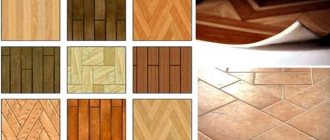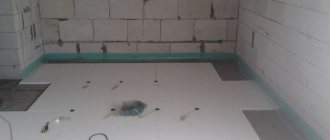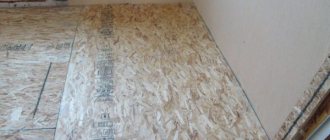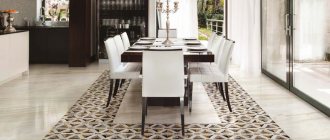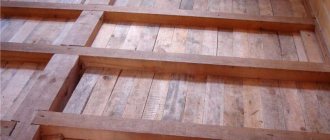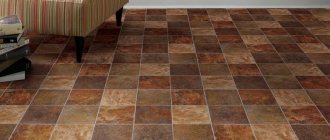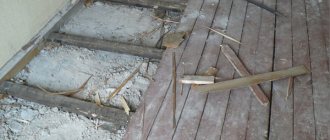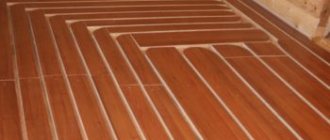The floor is a part of the interior for which characteristics such as practicality and durability are especially important.
If you want to install not just a stylish, beautiful, but reliable and high-quality floor, then vinyl laminate is ideal for you. It appeared on the market not so long ago, but has managed to become the most popular among other floor coverings.
Structure - main layers, their composition and purpose
PVC tiles consist of the following layers:
- The outer (front) protective layer is transparent polyurethane hardened by ultraviolet irradiation.
- Decorative layer - a pattern on a polymer film.
- The main layers are PVC with mineral (quartz) chips.
- Fiberglass - used in high-quality expensive composites. Prevents temperature deformation of the product.
- The final layer is made of PVC or adhesive compound. Depending on what material is in the base, different installation methods are practiced.
One of the most common laminate tile structures
Important! Budget brands of vinyl tiles can have only three layers: external protective, decorative and base. As a rule, such products are less strong and durable. There are also monolithic PVC tiles (usually modular), which are used mainly for cladding technical rooms.
Modular monolithic PVC tiles with relief - flooring in the garage
The thickness of multilayer tiles, depending on the brand, can vary between 1.5-3.5 mm. Monolithic, as a rule, has special stiffening ribs that increase the thickness of the product, but at the same time reduce the volume of raw materials used.
Cutting the material
In order for vinyl tiles to fit perfectly into the interior of a room, great attention must be paid to the correct cutting of its individual elements. It is worth considering that markings must be made on the front side of the product. First, the sticker is applied to the site of future fixation.
This area is then treated with an adhesive compound and the product is applied there.
In order to correctly make markings for placing stickers in hard-to-reach places (near radiators, door jambs), it is recommended to first make a cardboard template of the future location. Then cut out the tiles of the desired shape using it.
Format
The most common formats of PVC tiles are:
- square – side size varies from 30 to 60 cm;
- in the form of a board under laminate - there are standardized sizes 10x92, 18x92, 30x60 cm;
- modular - has a square shape, and locking connections are formed along the edges;
- hexagonal and triangular - as a rule, these are high quality products used in residential premises. With their help, you can create a floor covering with an original design.
The process of laying modular PVC tiles
Dimensions of triangular tiles and how to use them in the interior
Room design
You need to think carefully about the idea of your future design, based on your personal wishes and the size of the kitchen. Designs with large ornaments and dark shades should be used when the kitchen is large enough. If the kitchen is small, it would be optimal to choose a lighter material or an abstraction in the form of a small pattern.
To bring original design ideas to life, wall decoration with PVC tiles with an original texture is perfect. For example, for a classic type of finish you need to take wood-look tiles, and if you like the high-tech style, then imitation metal will highlight it well. For a minimalist style, brick-like tiles are suitable.
Where is it used?
The scope of application of PVC tiles is quite diverse. As a rule, these are rooms whose floors are subject to intense mechanical stress of various types: pressure, abrasion, impact deformation, combined with high humidity and other pollution factors. The use of LVT coating depends on its class.
- Class 23-31. (up to 2 mm) Average performance, small thickness of the outer coating up to 0.3 mm, which gives mediocre resistance to mechanical stress. As a rule, it is used in residential premises of medium intensity use: hallway, kitchen, glazed loggia, and for outdoor use - open balconies, verandas, terraces. Service life is about 5-6 years.
PVC tiles in laminate format in the living room
- Class 32-41. (2-2.5 mm) The front covering has an average thickness of 0.3-0.5 mm. The tiles are suitable for installation in rooms with average human traffic: office, retail and commercial premises. Most manufacturers position the service life of commercial PVC coatings at least 15 years.
PVC covering in the office
- Class 43 + special parameters. The tile has a maximum thickness of the outer coating, more than 0.5 mm, or it is monolithic. Used in rooms with maximum or special loads: gyms, medical or educational institutions (special requirements for environmental cleanliness), factory floors, laboratories, chemical, food and pharmaceutical industries.
Vinyl tiles in school lobby
Types of PVC coating according to installation method
In addition to classification by degree of load, PVC tiles are distinguished by installation method.
- Glue. This type of flooring comes in any class. The back surface is rough to improve adhesion; chamfers can be selected along the edges of the front side. Installation is carried out using special glue or mastic.
The best quality fastenings, according to experts, are provided by the following adhesive mixtures:
- Thomsit UK 400;
- Thomsit K188E;
- Deco Bond SSANGKOM;
- Homakoll 208.
The disadvantage of this coating is the need for careful preparation of the base.
Adhesive for laying PVC flooring
- Self-adhesive. Available in both square and laminate formats. An adhesive layer is applied to the lower part, which is protected by a polymer film. The base can be any non-deformable and non-absorbent surface: plywood, chipboard, OSB, cement-sand screed, tiled flooring, etc.
Among the advantages of such tiles, it is necessary to note quick and convenient installation. However, according to most experts, such a coating requires ideal surface preparation, and is also quite sensitive to external influences. In particular, it has a narrow range of temperature and humidity operating conditions, and if they are systematically violated, the tiles may peel off from the base.
Self-adhesive PVC laminate coating
- Glueless. Laying without the use of adhesive agents is typical for large-format thick-layer or monolithic quartz-vinyl tiles.
Installation can be carried out in several ways:
- using a click connection similar to laminate;
- using “puzzle” type end locking connections;
- joint to joint - without the use of locks.
According to the manufacturers, such elements are held together and on the base due to the geometric stability of their shape, as well as the spongy structure of the lower layer. The thickness of such products ranges from 4.5-7 mm. Due to the large thickness, certain defects in the base surface are allowed, which increases wear resistance and service life. The installation itself is very quick and does not require knowledge or any skills. However, such products are the most expensive on the PVC flooring market.
Industrial PVC tiles for glueless installation with hidden locking joints
Linoleum
A traditional vinyl floor covering that is inexpensive and quick to install. Linoleum is sold in rolls of various widths. It differs not only in texture and patterns, but also in the number of layers and the type of bottom layer.
It is worth noting that all types of vinyl floor coverings differ in wear resistance class. It is not uncommon for linoleum sellers to ignore this characteristic parameter, but it exists. True, it is not particularly important for apartments, due to low traffic.
Main characteristics - operational advantages and disadvantages
- Environmental friendliness. Despite the fact that most manufacturers position their products as environmentally friendly, biologically inert and hypoallergenic material, some brands are not recommended for use in residential areas. As a rule, the labeling of products indicates their area of application. For housing, it is better to use only multilayer tiles with an outer polyurethane layer.
- Water resistance. Polyvinyl chloride does not absorb water, however, for rooms with high humidity (kitchens, bathrooms, washrooms), it is recommended to use products with laminate-type locking joints, which provide additional tightness.
The moisture resistance of PVC tile flooring ranges from waterproof to completely sealed
- Anti-slip effect. The front surface of the product can be either smooth or with a relief, which significantly increases slip resistance. If in tiles used for technical premises such a relief has a purely utilitarian appearance, then for materials used in an office or home, the relief is part of the decorative embossing or texture of the pattern.
Relief embossing on a wood-imitating surface
- Impact resistance and wear resistance. Regardless of the class, the material can withstand significant mechanical stress, leading to damage to almost all other types of floor coverings (except for polymer poured and some types of especially durable concrete floors). The main parameter characterizing high performance indicators is impact strength.
- Thermal stability. The operating temperature range at which the material does not deform for ordinary household PVC tiles is -200C...+300C. Monolithic products can also be used outdoors. However, it should be remembered that at temperatures below -300C they become brittle and cannot withstand the calculated mechanical loads.
The device shows the high thermal inertness of PVC flooring
- Fire hazard. Quartz-vinyl tiles belong to fire resistance class B1 - they do not support combustion;
- Hygienic and easy to clean. PVC coating can be used both in children's and medical institutions. Sanitary-epidemiological and hygienic conclusion No. 026231. For cleaning, it is recommended to use neutral detergents or special vinyl care products.
- Antistatic. The material does not conduct electricity and does not accumulate static, this prevents the accumulation of dust and greatly facilitates cleaning.
- Chemical resistance. Depends on the production method and structure. Multilayer PVC tiles with an outer polyurethane layer are the most chemically resistant. Monolithic grades may be exposed to certain chemicals and solvents such as kerosene, gasoline, etc.
- Soundproofing. PVC coating does not produce sounds when used like a wooden plank floor or parquet; in addition, it muffles acoustic sounds and prevents the spread of shock and vibration noise.
Care
The cladding lasts a long time if it is regularly looked after.
As a rule, this is done once a week so as not to worsen her condition. The easiest way is to wash the tiles with ordinary soapy water. Another option is to use a mild detergent that does not contain abrasive ingredients. If there is persistent contamination on the surface, use a solution of ammonia or acetic acid. It is permissible to use ready-made formulations sold in household chemical stores, strictly following the instructions. The use of modern decorative materials is a completely new approach to the design of any interior. They are much cheaper than traditional ones and make it possible to turn the most daring projects into reality.
Criterias of choice
It is recommended to select PVC tiles according to the following criteria:
- strength (class 23-43);
- wear resistance (T, P, M, F);
- design;
- format.
To determine the values of the parameters, it is necessary to analyze the intensity of use of the room. Most manufacturers, in addition to numerical indicators of product strength, provide more detailed explanations designed for non-professionals. For example, for domestic use, semi-commercial, underfloor heating, etc.
A wide selection of colors and textures of PVC tiles, combined with the exact geometric dimensions of various batches, allows you to create a unique flooring design
As for the tile format, it all depends on the features of the room where the flooring needs to be installed:
- for small rooms it is advisable to use small square or rectangular tiles, this visually increases the area;
- When covering corridors and long rooms with PVC coating in the form of laminate, the elements should be oriented across the room or at an angle.
Features of laying tiles
Laying PVC tiles is a much less labor-intensive process than installing most floor coverings. However, it also requires careful preparation of the surface, as well as special care when installing starting rows. Depending on the type, there are three main technologies for laying vinyl flooring.
Various design options for laying PVC coating, arrangement of elements and appearance in the interior:
Tools used
Most of the tools that may be needed when laying PVC tiles are at the disposal of any self-respecting home craftsman. No specialized or expensive devices are required. This is another advantage of PVC coating. For ease of use, some tools are undergoing slight modernization:
- metal one- or one-and-a-half meter level, ruler or rule. Used for support when cutting. To prevent the metal tool from sliding on the surface of the tile, double-sided tape is glued to its back side and lightly sprinkled with talc, plaster or flour.
- stationery or construction knife with replaceable blades;
- tape measure, square;
- rubber hammer - if the coating will be laid with end locking connections;
- lapping is an ordinary wooden block on which several layers of felt are stuffed. Used for self-adhesive tiles. Special rollers for rolling are sold on the market, but for small volumes of work their purchase is unjustified;
- notched trowel - if the coating is laid on glue. The tooth should be triangular, small 1x2 mm;
- construction hair dryer - necessary if you need to lay tiles bypassing pipes. It is used to heat the material, after which it is much easier to cut.
Roller for rolling PVC laminate
Important! Cutting PVC coating is quite easy. An incision is made on the front side. After this, the material is bent along the cut line and the inner layers are cut. To make bending easier, it is recommended to first heat monolithic and thick-layer tiles with a hair dryer.
Preparing the base
The base material can be cement-sand screed, moisture-resistant plywood, OSB, fiberboard and other sheet materials. They must be pre-treated with a primer (especially the screed) to normalize moisture absorption. In some cases, installation on old flooring, such as tiles, is allowed. However, all intercellular spaces must be carefully sealed at the same level as the tiles.
The best option is to use a new subfloor made of moisture-resistant plywood with a thickness of 15-18 mm. The slabs are laid with offset seams. Gaps up to 2 mm wide are left between them to compensate for thermal expansion. The seams are carefully sealed with acrylic sealant.
Laying process
- On glue. Special glue is applied to the surface of the base with a notched trowel. It is necessary to distribute the mixture evenly over the entire contact area. Depending on the type of adhesive, tiles can be laid immediately after application or after some time of 2-5 minutes. After laying the PVC tiles on the glue, they are carefully tapped with a rubber hammer or rolled and ground. The purpose of these manipulations is to completely get rid of the air under cover.
Laying PVC tiles with glue
- On a self-adhesive base. All actions are absolutely similar to laying PVC tiles with glue, the only difference being that you do not need to apply the adhesive mixture. It must be taken into account that the amount of adhesive on the back side of the tile is small, so dusting of the adhesive layer or the surface of the base must be avoided in every possible way.
Laying self-adhesive PVC laminate on old ceramic tile flooring
- With a lock. Regardless of the type of interlocking connections, installation is carried out from the far wall. If necessary, the fasteners are cut on one side (if the first tile is located in a corner, on both sides). They retreat from the wall to the width of the expansion joint - 2-3 mm. Subsequent elements of the composition are joined to the first, driving the locking joints, especially the end ones, by lightly tapping with a hammer.
The process of laying tiles with a lock
Consumer Reviews
Despite the fact that PVC tiles have been used for a relatively short time, there are many consumer reviews on the Internet describing their use:
Detailed report on the installation and operation of FineFloor PVC tiles:
More details on Otzovik: https://otzovik.com/review_4025634.html
FineFloor PVC tiles
Review of Tarkett “Lounge” vinyl tiles:
More details on Otzovik: https://otzovik.com/review_4190458.html
Tarkett Lounge Vinyl Tile
Review of quartz vinyl PVC tiles Art Tile:
More details on Otzovik: https://otzovik.com/review_1071990.html
Quartz Vinyl PVC Tiles Art Tile
Review of Tarkett “New Age” PVC vinyl tiles:
More details on Otzovik: https://otzovik.com/review_5165800.html
Tarkett New Age PVC Vinyl Tiles
